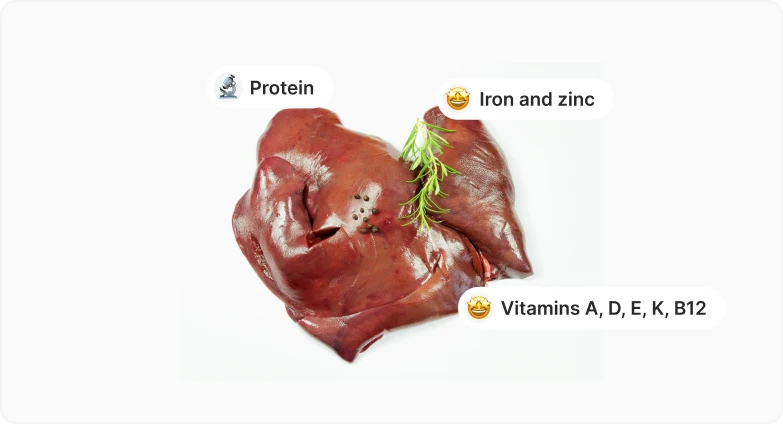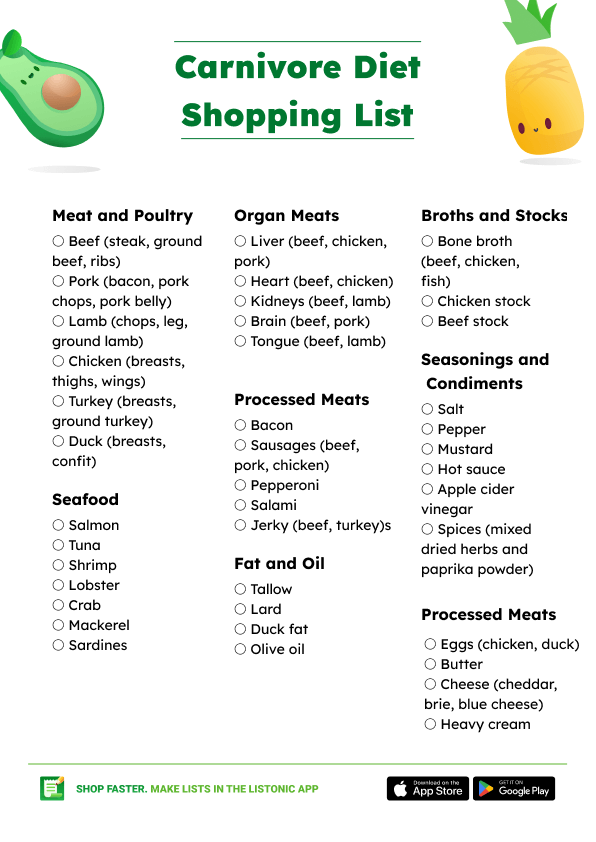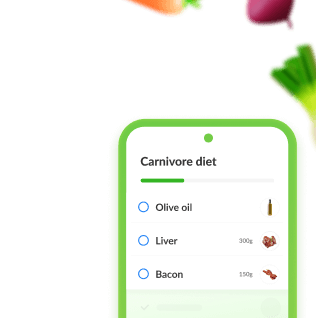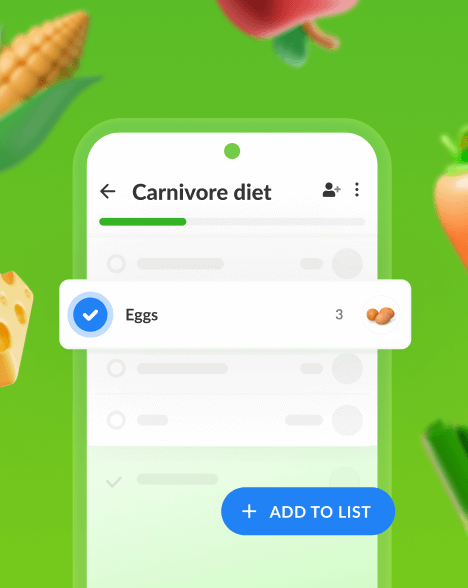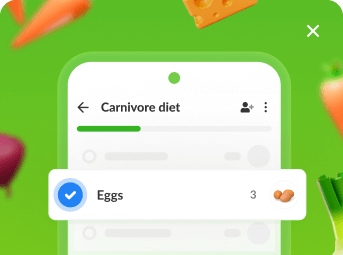Privacy Policy | Terms of services | Consent choices | © 2006-2024 Listonic. All rights reserved. Listonic Dev, and Listonic Ads are part of Listonic.
Carnivore Diet Food List (+ PDF)
June 27, 2023
The carnivore diet is a dietary approach that consists of animal products and eliminates or restricts the consumption of most plant-based foods. The primary principle behind the carnivore diet is that humans have evolved to eat animal foods, and that plants and carbohydrates are unnecessary or potentially harmful. In this article, we explore the carnivore diet and its main principles to help you get started. We also provide you with a convenient shopping list that aligns with this dietary approach.
Table of contents
Carnivore Diet Food List
Basic Carnivore Diet Guidelines
Carnivore Diet Food List Breakdown
What Else to Keep in Mind?
Conclusions
Carnivore Diet Food List
Meat and Poultry
Seafood
Organ Meats
Processed Meats
Eggs and Dairy
Fats and Oils
Broths and Stocks
Seasonings and Condiments
Basic Carnivore Diet Guidelines
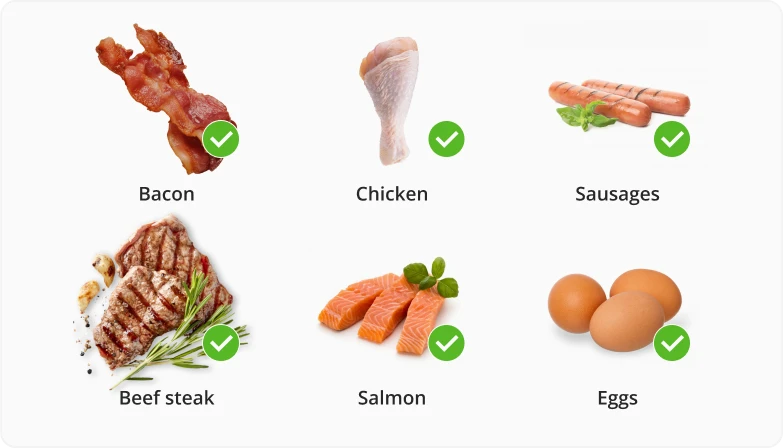
The carnivore diet revolves around prioritizing animal-based foods. Typically, it would include meat, poultry, seafood, and animal-derived fats which offer nutrients like protein, healthy fats & minerals.
This translates to excluding fruits, vegetables, grains, legumes and even some dairy items from your meals. The underlying thought here is that these plant-based foods may contain potentially harmful components and substances like anti-nutrients that could have a negative impact on your digestion or overall health.
However, you should keep in mind that are no scientific studies to support these claims. This diet is still yet to be properly studied.
Carnivore Diet Food List Breakdown
Meat and Poultry
Meat and poultry are the fundamental components of a carnivore diet, because they contain crucial proteins, vitamins, and minerals. Think of beef, which includes options like steak, ground beef, and ribs – it’ an essential choice owing to its delightful flavor and versatility. Other types of meat you can include are pork, lamb, turkey or chicken.
Seafood
It provides a range of nutrients, specifically omega-3 fatty acids. Fatty fish like salmon, tuna, and mackerel are known for their high omega-3 content and beneficial effects on cardiovascular health.
Additionally, shrimp, lobster, and crab offer a good amount of protein and minerals while also adding to the culinary enjoyment. Sardines, being a small oily fish, are packed with omega-3s and provide great nutrition for those following a carnivore diet.
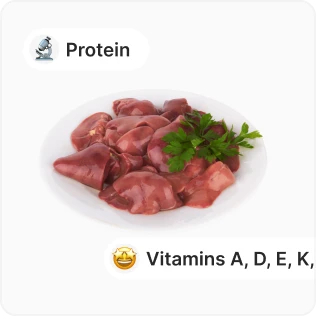
Organ Meats
Organ meats are considered highly nutritious and beneficial for a carnivore diet due to their concentrated nutrient profiles. Liver, available in beef, chicken, and pork, is a nutrient-dense organ rich in vitamins A, D, E, K, B12, and minerals like iron and zinc.
Hearts, from both beef and chicken, offer high-quality proteins and various vitamins and minerals. Kidneys, from beef and lamb, provide essential nutrients, including vitamin B12 and selenium. Beef and pork brain is a source of omega-3 fatty acids and nutrients like choline, while tongue is a tender and flavorful organ meat that adds diversity to the diet.
Processed Meats
While whole cuts of meat are a primary focus of a carnivore diet, processed meats can be included in moderation. Bacon, sausages (beef, pork, and chicken), pepperoni, salami, and jerky (beef and turkey) can be enjoyed as convenient options.
These products are often cured or seasoned, providing additional flavor, but it’s important to select options without added sugars or fillers.
Eggs and Dairy
They can serve as valuable sources of animal-based protein and fats. Both chicken and duck eggs are incredibly versatile and contain a wealth of essential nutrients. Butter, being rich in saturated fats, can be utilized for various cooking techniques and to enhance flavors.
Additionally, different types of cheese such as cheddar, brie, and blue cheese offer an array of textures and flavors while providing proteins and fats. For those seeking a high-fat option, heavy cream derived from dairy is an excellent choice for both cooking purposes and as a creamy addition to beverages.
Fats and Oils
Fats and oils are crucial for energy and satiety on a carnivore diet. Tallow, lard, and duck fat are animal-based fats that can be used for cooking and roasting, adding richness and depth of flavor. Olive oil, while not an animal-based fat, is a widely available option that can be used in moderation for cooking.
Broths and Stocks
Broths and stocks provide a way to extract nutrients from bones and connective tissues. Bone broth, available in beef, chicken, and fish variations, is a nutrient-dense liquid that contains amino acids, collagen, and minerals. Chicken and beef stocks are flavorful bases for soups and sauces, and they offer additional nutrients and depth of taste.
Seasonings and Condiments
They can improve the taste of carnivore dishes while still respecting dietary principles. Essential seasonings like salt and pepper can be used to enhance the flavor of different meats. Tangy and spicy kicks can be achieved by incorporating mustard and hot sauce without added sugars into dishes. Apple cider vinegar, on the other hand, is a flexible ingredient that can elevate dressings, marinades, or overall flavor profiles of various dishes.
Get a Carnivore Diet Grocery List on Your Phone!
Add & remove items
Sort items by store aisles
Share the list with your partner
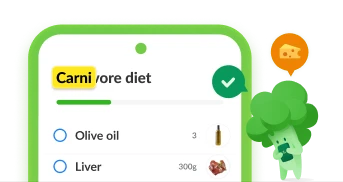

What Else to Keep in Mind?
What Foods to Avoid?
When following a carnivore diet, there is a specific list of foods that are typically avoided to maintain the dietary principles. By eliminating or significantly reducing the consumption of these foods, individuals aim to maximize nutrient intake from animal sources and minimize potential adverse effects of plant-based components.
Fruits and Vegetables: All fruits and vegetables, including berries, leafy greens, root vegetables, and other plant-based produce, are eliminated from the diet.
Grains and Legumes: Foods such as wheat, rice, oats, corn, beans, lentils, and other grains and legumes are not consumed on a carnivore diet.
Processed and Refined Foods: Processed and refined foods like bread, pasta, crackers, cookies, and other packaged foods containing plant-based ingredients are avoided.
Sugar and Sweeteners: All forms of added sugars and sweeteners, including natural sweeteners like honey, maple syrup, and artificial sweeteners, are typically excluded from the carnivore diet.
Dairy Products: While some individuals on a carnivore diet include dairy products like butter and cheese, other dairy products are generally to be avoided. However, it varies based on personal preference and tolerance.
Carnivore Diet Snack & Dinner Ideas
For those who are new to the carnivore diet, meal preparation can pose a challenge. To assist you, we have prepared a selection of carnivore-friendly meal ideas that adhere to the principles of the diet, offering inspiration and guidance for flavorful and satisfying meals.
Seared Salmon with Herb Butter: Delight in a beautifully seared salmon filet, seasoned with salt and pepper to highlight its natural taste. The salmon is cooked until it flakes easily and develops a crispy skin. Top it off with a dollop of herb butter, made from high-quality butter and a medley of aromatic herbs. The creamy and flavorful butter enhances the richness of the salmon.
Grilled Chicken Thighs with Bacon: Savor succulent and flavorful grilled chicken thighs, seasoned with your favorite spices or herbs. The chicken is cooked until the skin turns crispy and the meat becomes tender and juicy. For an extra touch of indulgence, wrap each chicken thigh with crispy bacon before grilling. The combination of smoky bacon and juicy chicken creates a satisfying and protein-rich dinner.
Pan-Seared Scallops in Ghee: Delight in plump and buttery scallops, seared to perfection in ghee, a clarified butter with a rich and nutty flavor. Season the scallops with salt and pepper, and cook them in a hot skillet until they develop a golden crust on the outside while remaining tender and delicate inside. Enjoy the pure and delightful taste of high-quality seafood.
What Are the Cons of a Carnivore Diet?
While the carnivore diet has gained popularity for its potential benefits, it's important to consider the potential drawbacks and dangers associated with this dietary approach.
The exclusion of plant-based foods, such as fruits, vegetables, whole grains, and legumes in the carnivore diet can result in potential nutrient deficiencies. This includes vital nutrients like fiber, specific vitamins (such as vitamin C), minerals, and phytochemicals that are commonly found in plants. The absence of these nutrients may have an impact on long-term health outcomes.
Digestive Issues: It is worth noting that some people may encounter digestive discomfort during the transition to a carnivore diet. This is primarily due to the lack of dietary fiber, which can potentially lead to alterations in bowel movements, including constipation. In order to address such concerns, it is crucial to attentively heed your body's signals and make appropriate adjustments accordingly.
You should be aware of the potential health risks associated with following a carnivore diet as there is limited scientific research on its long-term effects. It has been observed that excessive consumption of specific types of meat, especially processed and red meats, can lead to an elevated risk of certain health conditions such as cardiovascular disease and certain types of cancer.
When examining the carnivore diet through an environmentally and ethically conscious lens, various concerns come to light. The notable environmental impacts resulting from large-scale animal agriculture must be acknowledged, while contemplation of ethical considerations regarding animal treatment and the long-term sustainability of our food system is imperative.
Conclusions
Now that you know more or less what to expect from a carnivore diet, you can start your diet by making a food list. Feel free to use our food list in a paper or digital form to make your next shopping trip even easier.
